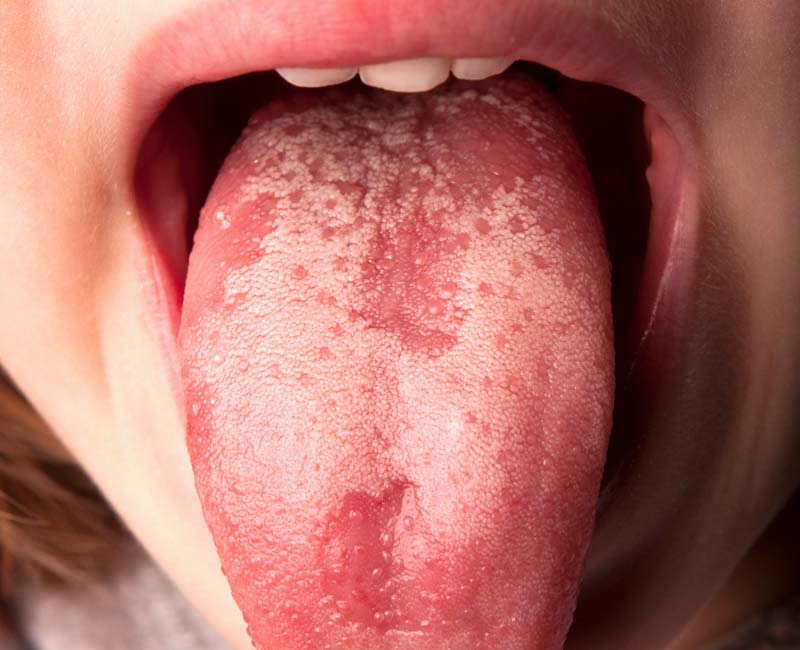Geographic tongue is a noncancerous condition that causes smooth reddish, patches on your tongue. It’s called geographic tongue because the patch patterns resemble the way that land masses and oceans are shown on maps. You can have geographic tongue without having symptoms. Geographic tongue is noncancerous, doesn’t cause health issues and doesn’t require treatment.
Advertisement
Cleveland Clinic is a non-profit academic medical center. Advertising on our site helps support our mission. We do not endorse non-Cleveland Clinic products or services. Policy

Geographic tongue is a noncancerous condition that creates patches of smooth, reddish skin on your tongue. Geographic tongue is benign, meaning it doesn’t spread. It’s called geographic tongue because the patch patterns resemble how land masses and oceans are shown on maps.
Advertisement
Cleveland Clinic is a non-profit academic medical center. Advertising on our site helps support our mission. We do not endorse non-Cleveland Clinic products or services. Policy
Geographic tongue isn’t painful and it’s not serious. But you should talk to a healthcare provider if you notice patches or other changes on your tongue.
That’s hard to say. Experts estimate about 3% of all people worldwide have geographic tongue. People with this condition may not have symptoms and may not seek medical care, so it’s possible that more people than estimated have geographic tongue.
Anyone can develop geographic tongue, from babies to children to adults. The condition is slightly more common in young adults than in older adults. It may occur in:
The most noticeable symptom is a pattern of smooth, reddish spots on your tongue with white or gray borders. Normally, your tongue is covered with papillae. Papillae are tiny, hair-like projections that protect your tongue. People with geographic tongue have fewer papillae than normal. The patches may come and go. Other symptoms may include:
Advertisement
Healthcare providers aren’t sure what causes the condition. They believe people with certain diseases are more likely to develop geographic tongue. Those diseases include:
People who don’t get enough zinc, iron, folic acid and vitamins B6 and B12 from their daily diet may have an increased risk of developing geographic tongue.
Food doesn’t cause geographic tongue, but spicy foods may create tingling or burning sensations where you have patches.
Healthcare providers diagnose geographic tongue by:
There’s no treatment to eliminate geographic tongue, but healthcare providers may recommend medication, including:
No, it can’t be cured. Geographic tongue often goes away on its own without treatment, but it can come back.
No, geographic tongue is a noncancerous disorder that doesn’t become oral cancer. That said, you should talk to a dentist or healthcare provider any time you notice changes in your mouth, such as white patches that could be signs of oral cancer.
Probably not. Healthcare providers aren’t sure what causes geographic tongue, but they believe people with certain conditions, like diabetes or skin issues, have increased risk of developing geographic tongue. You may be able to reduce your risk by eating a healthy diet that contains enough zinc, folic acid, iron and vitamins B6 and B12 and managing your stress.
You can’t get rid of geographic tongue. But there are things you can do to ease its symptoms, including:
Geographic tongue is a noncancerous condition that creates patches of smooth, reddish skin on your tongue. Geographic tongue is benign, meaning it doesn’t spread. Some people have geographic tongue without having noticeable symptoms. When they do, symptoms include patches on their tongue and burning and tingling sensations, especially when they eat spicy or acidic foods. If you spot changes in your tongue, talk to a healthcare provider so they can determine what caused the changes.
Advertisement
Cleveland Clinic’s primary care providers offer lifelong medical care. From sinus infections and high blood pressure to preventive screening, we’re here for you.

Last reviewed on 02/14/2023.
Learn more about the Health Library and our editorial process.